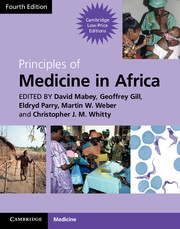Book contents
- Frontmatter
- Contents
- Contributors
- Foreword
- Section 1 Health and disease
- Section 2 Mother and child health
- Section 3 Infection: general principles
- Section 4 Major common infections
- Section 5 Bacterial infections
- 22 Typhoid, paratyphoid and non-typhoid Salmonella infections
- 23 Streptococcus pyogenes and Staphylococcus aureus
- 24 Rickettsial infections
- 25 Brucellosis
- 26 Leptospirosis
- 27 Relapsing fever
- 28 Plague
- 29 Anthrax
- 30 Tetanus
- 31 Diphtheria
- 32 Leprosy
- 33 Cholera
- Section 6 Viral Infections
- Section 7 Protozoal infections
- Section 8 Helminth infections
- Section 9 Fungal infections
- Section 10 Non-communicable diseases
- Section 11 Diseases of body systems
- Section 12 Cancer and Palliative Care
- Section 13 Venoms and Poisons
- Index
- References
30 - Tetanus
from Section 5 - Bacterial infections
Published online by Cambridge University Press: 05 March 2013
- Frontmatter
- Contents
- Contributors
- Foreword
- Section 1 Health and disease
- Section 2 Mother and child health
- Section 3 Infection: general principles
- Section 4 Major common infections
- Section 5 Bacterial infections
- 22 Typhoid, paratyphoid and non-typhoid Salmonella infections
- 23 Streptococcus pyogenes and Staphylococcus aureus
- 24 Rickettsial infections
- 25 Brucellosis
- 26 Leptospirosis
- 27 Relapsing fever
- 28 Plague
- 29 Anthrax
- 30 Tetanus
- 31 Diphtheria
- 32 Leprosy
- 33 Cholera
- Section 6 Viral Infections
- Section 7 Protozoal infections
- Section 8 Helminth infections
- Section 9 Fungal infections
- Section 10 Non-communicable diseases
- Section 11 Diseases of body systems
- Section 12 Cancer and Palliative Care
- Section 13 Venoms and Poisons
- Index
- References
Summary
The problem in Africa
Tetanus is caused by toxins produced by Clostridium tetani and is characterized by increased muscular tone and spasms. It is commonly known throughout Africa as ‘lockjaw’, since spasms of the masseter muscles prevent the mouth from opening. Although it occurs in two different clinical situations, neonates (neonatal tetanus) and older children and adults (non-neonatal tetanus), the pathophysiology is similar.
Tetanus was first described in Egypt over 3000 years ago. Although vaccination has been available since 1923, tetanus still causes mortality in Africa. Neonates account for over 40 per cent of the patients admitted to hospital with tetanus in some areas, and have the highest mortality rates. Despite an international resolution to eliminate neonatal tetanus (NNT) by 1995 and again by 2005, the World Health Organization (WHO) estimated in 2004, 128 000 neonates died from tetanus (http://www.who.int/immunization_monitoring/diseases/MNTE_initiative/en/index.html).
Non-neonatal tetanus remains an important cause of admission to hospitals in West, Central and East Africa. Maternal tetanus (occurring during pregancy or within 6 weeks of delivery or termination) was estimated to account for 5 per cent of maternal morbidity in the 1990s (Roper et al., 2007), and in 2012 the WHO reported that maternal and neonatal tetanus had been eliminated from a further 34 countries, although they remain a problem in 34 countries, mostly in Africa.
- Type
- Chapter
- Information
- Principles of Medicine in Africa , pp. 345 - 350Publisher: Cambridge University PressPrint publication year: 2013



